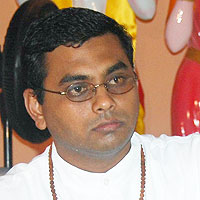Young children in today’s society join social groups at an early age. They do so when they enter nursery school, pre-school, attend music class, dance class, etc. In this way their social environment expands. The social environment is the sum of all our relationships, especially the close relationship we have with family members and friends. Such relationships make us who we are because other people influence how we think, how we feel, how we behave.
So parents, the time when our young children begin to extend their social environment is also the time we should begin to pay particular attention to moulding their Hindu social self. We must inject Hindu information and experiences in their lives in such a way that it becomes a natural way of life for them. Television shows, story books, learning Hindi, praying, playing musical instruments, performing ‘pooja’ and participating in Hindu ceremonies and events are key to establishing a Hindu framework of existence for our children. Introduce them to real Hindu superheroes/heroines who deliver, such as Lord Hanuman who can fly and destroy demons; Lord Shiva who can burn evildoers with his third eye; Durga Maa who can tame a tiger to save us from harm and Saraswati Devi who can bless our intellect and help us pass our exams.
In my experience, children who had this early Hindu exposure are the ones who feel proud enough to flaunt their Hindu social selves in public. They are the ones who truly carry the flagship of Hinduism in our multicultural society. Naturally, the reverse holds true for children who are robbed of a Hindu identity by their first significant others. I remember trying to get volunteers to read a poem for a Divali programme at my school. To borrow a line from an English story, “not a {Hindu} creature stirred”. Believe it or not, it was a non-Hindu, non-East Indian student who volunteered. Not only that, she insisted on wearing a sari, bindi and other Hindu accessories. And so, on the day of the event, despite a significant Hindu population in the school, it was this non-Hindu child, fully bedecked in traditional wear, who proudly took to the podium and belted out, “The Lights of Divali”. Her only request was that I let her have the costume jewellery Indian earrings I was wearing. I found that to be a just reward for her.
Adolescence is a difficult period of adjustment for both young boys and girls. The shaping of the adolescent’s social self is crucial to developing a healthy social adult self. All adolescents seek acceptance in groups. Hence they can easily become victims of fads and youth peer groups. Most times the ideas and opinions of these groups mean more to them than those of their parents. Very often this negative characteristic of the generation gap results in the severing of relationships between parents and teenagers or resentment of criticism and advice from parents. Next month, we look at ways to nurture the adolescent Hindu social self.
By Mrs. Mala Persad


